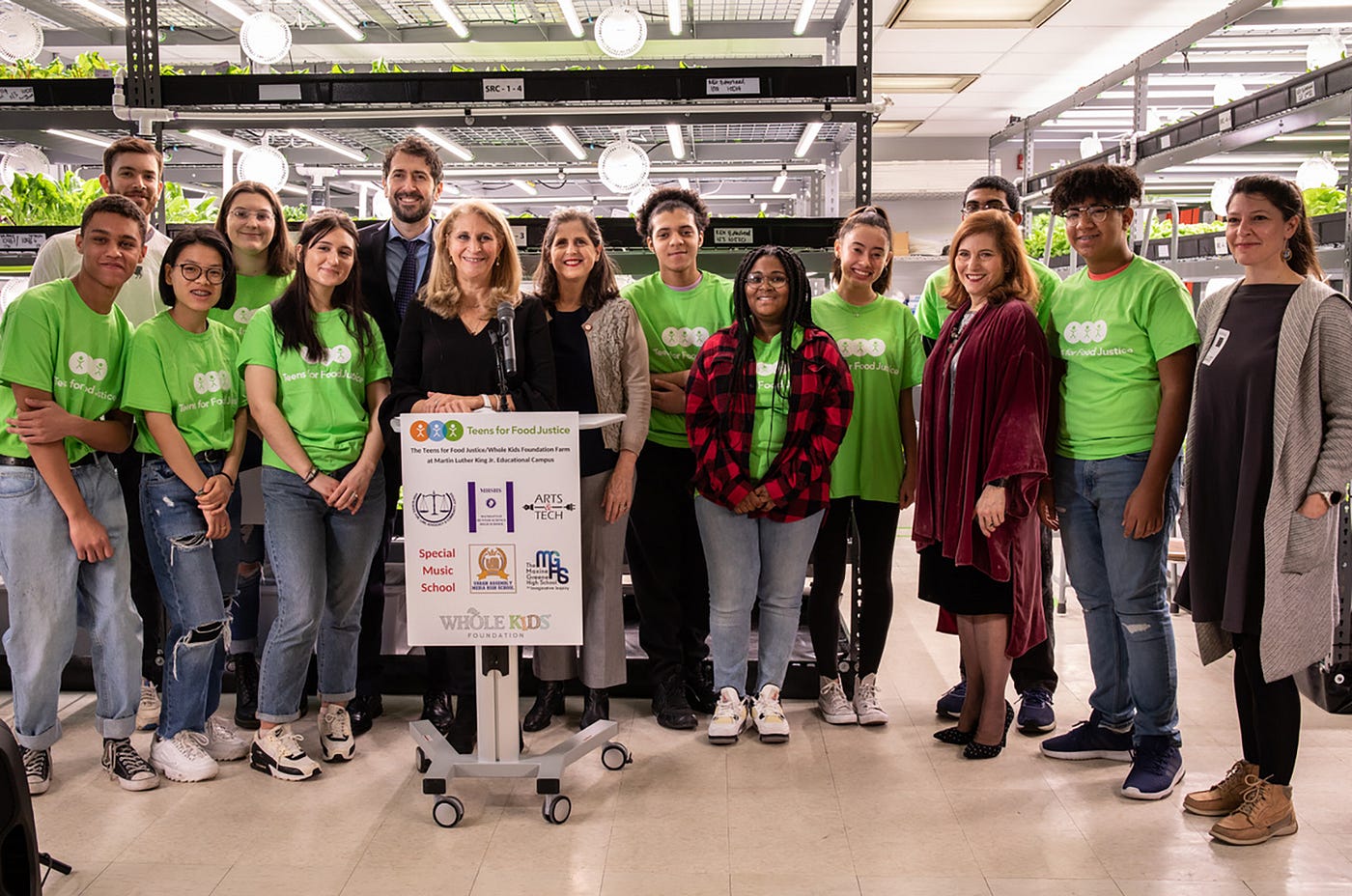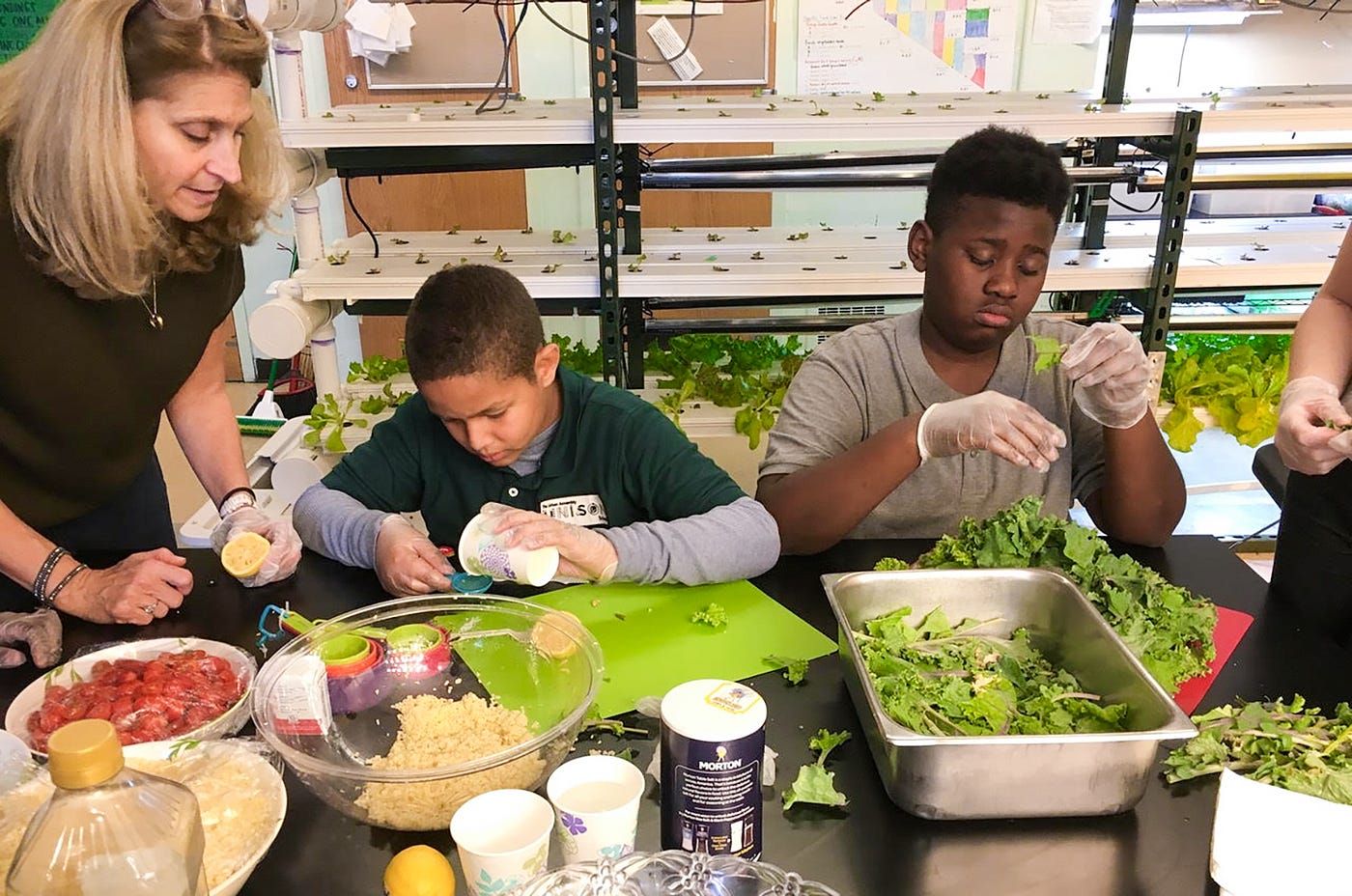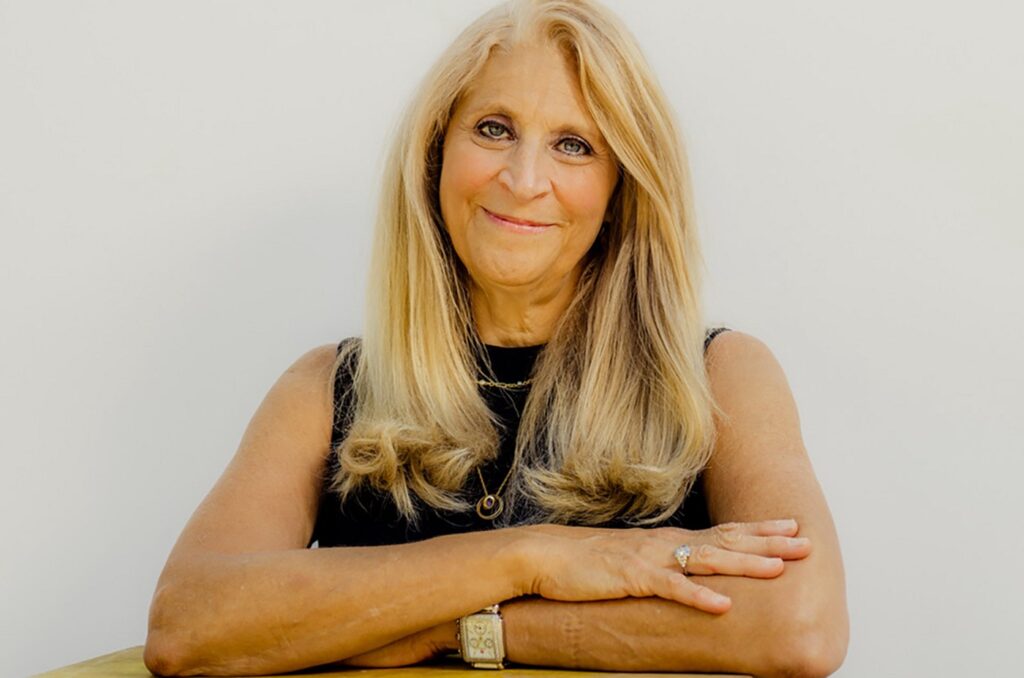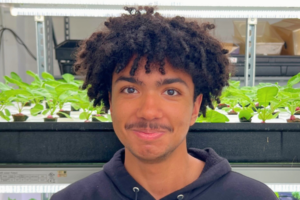By Martita Mestey | Published July 19, 2021 in Medium via Authority Magazine

In many parts of the United States, there is a crisis caused by people having limited access to healthy & affordable food options. This in turn is creating a host of health and social problems. What exactly is a food desert? What causes a food desert? What are the secondary and tertiary problems that are created by a food desert? How can this problem be solved? Who are the leaders helping to address this crisis?
In this interview series, called “Food Deserts: How We Are Helping To Address The Problem of People Having Limited Access to Healthy & Affordable Food Options” we are talking to business leaders and non-profit leaders who can share the initiatives they are leading to address and solve the problem of food deserts.
As a part of this series, we had the pleasure of interviewing Katherine Soll, TFFJ CEO/President.
Katherine Soll is a lifelong New Yorker who cares deeply about her city and believes that empowering a new generation with the knowledge and tools to correct injustice will lead to permanent and lasting positive social change.
She founded Teens for Food Justice (TFFJ) in response to her growing dismay and alarm as the city gentrified over the course of her lifetime and basic resources became less and less available in lower-income communities, particularly good quality, healthy food.
Her previous leadership experience includes high-level roles in management and marketing in the for- and not-for-profit sectors.
Thank you so much for doing this with us! Before we dig in, our readers would like to get to know you a bit more. Can you tell us a bit about your “backstory”? What led you to this particular career path?
Ihave lived my entire life in New York City — in Greenwich Village until the age of 7 and, thereafter, on the Upper West Side. Growing up in the 1960s and 70s, I listened to my immigrant grandparents’ stories of community joining together to help new arrivals find their footing in a new world while being surrounded by the widespread civic engagement and activism unfolding all around me. These combined experiences shaped my belief that all people deserve to be treated with dignity and respect, and that if we are fortunate to be born into a secure home and live a good life, we must pave the way for others to achieve those goals, as that is the basis for a successful society.
When I was 26, my father died, leaving a small business that supported my mother. Despite having no knowledge of business management, accounting, or direct experience in the organization, I took over the books, client interface, and personnel management, quickly securing the resources I needed so it could thrive and secure my mother’s financial future.
To my surprise, I found that I had an aptitude for the work. I encouraged clients who were used to working with my highly experienced father to take a chance on me and identified mentors and sources of information that could help me develop the skills I lacked. I ran the business for almost seven years, substantially growing its revenue and securing new opportunities, including a large and lucrative contract as Kmart’s consultant to its Martha Stewart license when I was only 28 years old. When my mother was ready to retire, we successfully divested the business. I am most proud that I helped my mother achieve a level of financial security that enabled her to live the rest of her life in comfort and ease.
I married another Upper Westsider whose mother taught Kindergarten in the public school we both attended; our home is a block away from where I grew up, nine blocks from his childhood home, and within one mile of the rest of our family. I have benefitted from the unique perspectives of both a small-town and big city story.
I have been extremely fortunate. I attended college, successfully ran one business, founded another one, and raised two children to independent adulthood. During this time, the world has experienced huge social movements, seismic political shifts, multiple wars, and a pandemic. These events have shaped me, but I have not dramatically suffered their impacts. However, I have watched a very different story unfold for fellow New Yorkers who, because of the color of the skin or their immigration status, didn’t start life with the promise of a good education, plentiful, nutritious food, decent housing, and some savings in the bank. This knowledge reinforces my conviction that I have an obligation to try to even the playing field, and I bring that conviction to my work at TFFJ every day.
Can you share the most interesting story that happened to you since you began your career?
When Gloria Estefan visited a one of TFFJ’s school-based hydroponic farms and sang to the plants, which made TV news! This happened in 2018, on the morning of our annual gala, when she and her husband Emilio were to be honored for their financial support and leadership in bringing TFFJ to Miami to address food insecurity in that city. A number of news stations filmed her visit, where she met with students to tour the farm and learn about hydroponics, and about their experiences growing their own food and advocating for food justice. Then, she asked if we played music for the plants and began to sing, sharing that singing to her plants helps them grow. The students were absolutely blown away. It was a moment of very personal connection to the program that she shared with all of us and the viewing audience. For me, it illustrated how deeply the various aspects of our program resonate with people across all demographics, backgrounds, and socioeconomic levels.
Are you able to identify a “tipping point” in your career when you started to see success? Did you start doing anything different? Are there takeaways or lessons that others can learn from that?
A good friend and colleague of mine is the founder of the Yale Alumni Nonprofit Alliance (YANA), a Yale University alumni organization focused on supporting the nonprofit sector. In 2014, when Teens for Food Justice was in its first year, the showcase event of YANA’s annual conference was a social enterprise pitch competition for national Yale-affiliated nonprofits and social enterprise ventures. Although I am not a Yale alum, I received an invitation to the conference through my friend. When I read about the competition, I immediately knew that I had to apply.
I submitted TFFJ’s application, as did many other groups and, at first, I did not make the cut. However, one of the six selected nonprofits had to drop out and, with less than a week until the competition date, I was notified that TFFJ was the runner-up and that I was now welcome to participate. I had never given a memorized fast pitch before and on top of that, I was a very nervous public speaker. With help from everyone I could think of, I wrote and memorized my pitch and presented, under a 90 second countdown clock, in front of 300+ audience members and “expert” judges — corporate and philanthropic leaders — who, together, would choose the winner. I was, by far, the least experienced presenter and most unfamiliar with this format. But I gave my pitch with passion, without a single error, and finished with one second to go on the clock. When the judges announced that I was the winner, I was amazed and incredibly proud, but also knew that I had really earned that honor.
This was a tipping point both for me and for the organization. For me, it was affirmation from a broad, unbiased audience that I had a truly compelling concept, while providing TFFJ outside validation from a highly respected and august institution in its very early days. It also confirmed my belief that TFFJ was a scalable program that could be implemented in cities across the US, and, even, globally, to address food insecurity and build future leaders for food justice. From then on, I began developing partners who could assist me in developing my strategic plan.
I think the lesson to take from this experience is don’t shy away from challenges — take them on. If you are truly passionate about your work and believe in yourself and your mission, you will find the tools and resources you need to accomplish much more than you think you can.

None of us are able to achieve success without some help along the way. Is there a particular person to whom you are grateful who helped get you to where you are? Can you share a story about that?
TFFJ is the organization it is today because of the partnership between myself and our co-founder, Tara Smith Swibel, who brought her passions for social justice, her unique vision, and her vast connections and resources to the creation of our program.
When Tara and I were connected in 2013, I was running an organization called Students for Service (SFS), an all-volunteer nonprofit, engaging youth in impact-oriented community service, that would inspire them to be the next generation of leaders for social justice. We had hundreds of students involved in the program, particularly in projects addressing hunger, food insecurity and the environment, but were unable to secure funding to build the infrastructure to sustain it. Over lunch one day, Tara and I discussed the things we were passionate about and she shared her concerns about our global agricultural system’s impact on climate and how hydroponic farming could be a real solution. In particular, she had a vision for building a hydroponic farm on the roof of every school and using the income generated by sales of the produce to high-end customers to purchase school supplies and materials, which could help level the playing field for children living in high poverty neighborhoods attending under-resourced schools.
As soon as she shared this vision, I saw what Students for Service could become. I saw local, school-based farms, run by students in their schools, that could train a generation of leaders in a new form of agricultural production that could feed communities in need while fighting climate change. I spoke to her about food deserts and how the students in the schools she most wanted to help had almost no access to the healthy, fresh produce these farms would grow and the terrible health and economic implications of these conditions. As with many people in 2013, the extent of US food insecurity, particularly among children, was new information, but she immediately understood the importance of correcting this inequity. We decided that I would research the feasibility of this project and get back to her. Two weeks later, I shared my proposal for Teens for Food Justice and a request for seed money. These funds, and a challenge grant we received through an online Crowdfunder, helped us quickly raise $100,000 to build our first farm at a school in Bed-Stuy within 6 months. We are now a $2.5M organization empowering hundreds of students to grow produce, hydroponically, at schools across New York City and, within the next year, in Miami and Denver. By 2022, we will provide 65,000 pounds of produce to thousands of residents in three states and build food and nutrition security in multiple US communities most impacted by these problems.
You are a successful leader. Which three character traits do you think were most instrumental to your success? Can you please share a story or example for each?
- Tenacity with flexibility — I never give up on my vision and beliefs but understand that I may need to flex my methods as circumstances change. An example is the evolution of Students for Service to Teens for Food Justice. My core vision was to build a new generation of leaders for a more just and equitable world; SFS and TFFJ share that vision. TFFJ hones the focus to food insecurity, but our advocacy work engages our students in exploring all of the systemic biases and inequities on which food insecurity rests. When TFFJ was founded in 2013, it required us to collapse the work of SFS, which was engaging hundreds of students in multiple projects addressing a range of issues, and build out again with a small cohort of youth addressing a single issue in a single location. Rather than viewing that shift as a failure of the core mission, I saw an opportunity and an exciting challenge to reshape and pave another pathway to our goal. I believe this point of view has been a critical aspect of my success, not only throughout the trajectory of this organization, but throughout my entire life.
- Vision — I am able to visualize the outcome I wish to see, in my life and in my work, even when the path forward is murky. I think that is a critical aspect of leadership — the ability to rise to the 30,000-foot view and see multiple paths forward, as opposed to being mired in the problems of the one you are currently on. When the pandemic hit and schools were abruptly closed, TFFJ had to shut down all of its farms. We faced an immediate existential crisis: without students farming and learning in school or food to distribute, what would TFFJ do and be? I immediately tasked our team with harvesting the 1,000 pounds of food currently growing in our hydroponic systems and distributing it to our local community partners, while learning about the challenges they were facing in meeting their served communities’ food needs during the COVID food crisis. We then connected with local commercial hydroponic growers and other food suppliers, who, due to the pandemic, had surplus food to donate and set up a robust plant-based free and affordable food distribution network in every community we serve through our farms. We worked with all of our funders to reallocate grants to support these distributions and to transform our curricular content to online formats and secured new funding to support these and other new programs. We provided hundreds of students with home growing kits, supported by online lessons, so they could continue their hydroponic STEM and food justice advocacy education through remote learning. And, through the remote environment, we developed partnerships for curricular day and after school programming with new schools in New York City and beyond, that will continue after schools and our farms reopen. I believe that having not only survived, but thrived, thanks to our ability to maintain TFFJ’s vision as our lodestar but adapt to the constantly changing circumstances during COVID, will lead to a better TFFJ overall when schools reopen in Fall 2021.
- Relatability — To me, leadership is a combination of vision, goal-setting, and engaging the wisdom and input of the right partners to achieve it. It is understanding that this wisdom will come from many places, not just experts in your field or those who can fund your work, but, also, those who are living the experience you are trying to address. As CEO of TFFJ, I interact with people at every level, from elected officials and business leaders to the students and constituents we serve. I believe that every one of those individuals has equally important ideas to share with me about our program and a voice that needs to be heard if we are going to do our best work. There is no single story but, rather, a multitude of stories and experiences from which you will find your inspiration, but you have to be open to them all and make sure that people want to share them with you.
Can you please give us your favorite “Life Lesson Quote”? Can you share how that was relevant to you in your life?
“Don’t Stop Thinking About Tomorrow,” a song lyric by the band Fleetwood Mac. It was my motto in my high school yearbook and remains the key to who I am today.
My determination to rise above the challenges of any given day and to find the path forward to a better tomorrow has been fundamental to who I am, to how I have approached every aspect of my life, and to my journey with and the success of Teens for Food Justice.
Ok super. Let’s now shift to the main part of our discussion about Food Deserts. I know this is intuitive to you, but it will be helpful to expressly articulate this for our readers. Can you please tell us what exactly a food desert is? Does it mean there are places in the US where you can’t buy food?
The Economic Research Service from the U.S. Department of Agriculture defines food deserts as areas with “limited access to supermarkets, supercenters, grocery stores, or other sources of healthy and affordable food.” Also, food deserts are considered to be areas where people live more than one mile from a supermarket in urban neighborhoods or ten miles away in rural areas, where only one out of ten food retail establishments sells fresh fruit or vegetables, and where food that is “culturally relevant” to the local population (i.e. foods traditional to their culture) is largely unavailable.
People who live in food deserts are more susceptible to experiencing food insecurity and diet-related diseases such as diabetes and cardiac disease, due to lack of healthy food in the communities they live in. This unfortunate reality is predominant in lower income communities, particularly those of color.
Despite minor gains in the years prior to the COVID-19 crisis–in 2019, the overall food insecurity rate was the lowest it had been in more than 20 years — more than 35 million people, including nearly 11 million children, were food insecure. Food insecurity remains a pervasive and pernicious issue that affects residents’ quality of life throughout the country and has been exponentially magnified by the COVID-19 pandemic. In fact, Feeding America projects that 42 million people (1 in 8), including 13 million children (1 in 6), may experience food insecurity in 2021.
Current research shows that the combined factors of poverty and food insecurity force people to consume large quantities of cheap, highly-processed, high-calorie/low nutrient foods, leading to obesity/diet-related illness, including diabetes and heart disease. Those who are at greatest risk are children, a fact that has tremendous implications, not only for our next generation’s long-term wellbeing and lifespan, but also for projected healthcare costs and our economy. These systemically-imbalanced inputs and outcomes are evident in the schools and communities where TFFJ works.
Food insecurity is a complex problem with many contributing factors. In a community where grocery stores and supermarkets are absent, people are forced to shop at convenience and other smaller stores, where healthy, affordable food options are limited. If grocery stores are present, these foods may be expensive, due to lack of competition, and the stores may not accept food assistance benefits. But, local demand also determines the types of food offered at grocery stores so even when grocery stores open in neighborhoods, education can play a major role in driving customer purchases of healthy food.
This is why, at TFFJ, we provide youth with advanced solutions to the lack of affordable, fresh food in food desert communities, including innovative approaches to growing food in urban environments, nutrition education, and the tools to advocate for a just food system for all. We are building the foundation for a sustainable social movement that can help to close the gaps in health and wellbeing between low and upper-income urban communities.

Can you help explain a few of the social consequences that arise from food deserts? What are the secondary and tertiary problems that are created by a food desert?
The social consequences of food deserts as a multilayer issue are most frequent in low-income, minority communities of African American, Latino and Native American populations. For example, data from Hungry Free America shows that in 2019, the household food insecurity rates were 19.1 percent for Blacks, 17.0 percent for Hispanics, and 7.9 percent for non-Hispanic whites. Additionally, the federal Department of Health and Human Services (HHS) has found that food insecurity rates for American Indians and Alaska Natives were double those of whites. Another two groups affected by the food crisis are single women and adults with mental health disabilities. In fact, food insecurity rates have exponentially increased in these two groups as a result of the unprecedented challenges caused by the pandemic.
The high costs associated with unhealthy eating are another part of the alarming consequences of food deserts. With a direct effect on public health, living in food deserts increases the risk of chronic conditions, such as obesity, diabetes, cardiovascular disease, and cancer. As a result, local healthcare systems are also impacted because people find themselves in dire situations in which they cannot afford to pay for treatments. In many cases, those costs are absorbed by local systems that were already struggling to meet these costs.
According to the Centers for Disease Control Prevention (CDC), 90% of the nation’s $3.8 trillion annual health care expenditures are allocated to cover people’s chronic health conditions. In New York City alone, in 2017, the cost of treating diet-related diseases exceeded $4 billion. Many of these conditions are related to poor diet and can be prevented and managed by interventions that make affordable healthy food more widely available so that people are less sick and less stress is placed on our healthcare system and economy. For instance, obesity, which causes at least 12 different types of cancers and affects 19 percent of children, can be treated with a healthy diet. The Cleveland Clinic indicates that at least 18 percent of all cancers and approximately 16 percent of deaths related to it are associated with weight and poor nutrition.
Where did this crisis come from? Can you briefly explain to our readers what brought us to this place?
There are multiple reasons for the current crisis of food insecurity. Primarily, it has been attributed to the growth of suburbs in the 1960s and 70s and the surge of private transportation. Post-World War II, there was a surge in population that helped create new housing developments within our cities, but also the widespread application of discriminatory housing policies (“red-lining”) that kept Black and Brown residents from moving into specific neighborhoods. Simultaneously, white people began moving out of urban areas into suburban ones as it became easier to purchase an affordable single-family home. Grocery stores followed both trends, concentrating operations into primarily white urban neighborhoods while, also, adapting to suburban communities, with larger stores that later became the big chain operators that dominant our landscape through large distribution networks. With grocery stores and supermarkets concentrated in middle class urban and suburban neighborhoods, lower income urban areas turned into food deserts, populated by convenience stores carrying few staple foods and more snacks, fast foods, and popular items, including tobacco, beer, and beverages high in sugar.
Now that gentrification has become a huge urban phenomenon — where higher-wealth individuals begin moving into lower income areas, driving up housing costs and driving out the existing, lower income population — cities are seeing new drivers of food insecurity. Food insecurity is also a direct result of “the meal gap,” a measure of how much money you have left to buy food each month once you have paid for other non-negotiable necessities, such as housing, healthcare, school tuition, etc. As a community’s housing prices rise due to gentrification, its residents must either allocate more of their money towards rent or move out. Those who stay are more likely to experience food insecurity unless they see equal rises in income, which is unlikely.
Food insecurity and food deserts are a direct result of political and economic decisions that, over time, created a giant gap in rates of employment, cost of housing, and access to transportation, quality education, and affordable healthy food, all of which have enormous impacts on quality of life and longevity.
Can you describe to our readers how your work is making an impact to address this crisis? Can you share some of the initiatives you are leading to help correct this issue?
TFFJ is catalyzing a youth-led movement to end food insecurity in one generation through high-capacity, school-based hydroponic farming. Through our program, TFFJ students grow large quantities of fresh produce in their Title I schools, building healthy food access within their communities as they learn about the health benefits of a plant-based diet and how to advocate for the policies that guarantee a healthy food system for all. Our students represent Black and Brown communities, which suffer disproportionately from food insecurity and its resulting poor health outcomes. Through the TFFJ program, young people from these communities master the skills and knowledge needed to be leaders of a new green economy where alternative methods of growing food are anticipated to be a multi-trillion-dollar business and to ensure that, as this industry grows, professional opportunities are more equitably available along with the fresh, healthy food it produces.
TFFJ provides a uniquely comprehensive approach to impacting food equity by using schools as hubs of a multi-pronged, youth-led, community-focused approach to social change. Our school-based, large-scale hydroponic farms integrate three streams of work, each serving a different component of our food equity and access vision.
- Our curricular day program consists of standards-aligned lessons that are integrated into a variety of STEM classes and co-taught by a TFFJ Farmer-Educator and one of the school’s licensed teachers. Students use the farm as a lab to learn about everything from plant biology to food seasonality; malnutrition to nutrient cycles; ecosystem diversity to resource management; and more. Our program evaluation results show a majority of participating students feeling not only more prepared to handle STEM subjects, but also more knowledgeable about (and motivated to eat) healthier foods and better able to share what they’ve learned with friends and family.
- Our afterschool Apprenticeship program offers students from all schools on campus — including those who may not participate in an integrated class during the curricular day — the opportunity to become food justice advocates using social entrepreneurship as their tool. Along with the basics of hydroponic farming, harvesting, and cooking with the resulting produce, student activities focus on how limited access to healthy, affordable food impacts community health and what they can do about it. A full 100 percent of our last cohort of participating students reported that our Apprenticeship program helped them understand how nutritious food makes a positive difference in their health, and 95 percent feel that they are more of a leader after the program and can advocate for food justice.
- Our distribution channels provide multiple avenues for each school and its surrounding community to enjoy and learn more about healthy, affordable food. The farm’s produce feeds all students every day through each school’s cafeteria, and students manage a robust weekly distribution of our produce to community partners and directly to local residents, and offer cooking demonstrations and food tastings that familiarize community members with the foods they grow, how they contribute to better health, and how to prepare and enjoy them. They also share what they have learned about the policies and practices that have led to our country’s current broken food system and how to advocate for food justice.
We are the only organization providing this multilayered approach to food justice work in schools at a scale that can also feed entire school populations and communities at large. Through their lunches, their classes, their afterschool time, and their work opportunities, students learn how nutritious food grows, how it impacts their bodies, and how to turn this knowledge into healthier futures for themselves and their communities.
Can you share something about your work that makes you most proud? Is there a particular story or incident that you found most uplifting?
What always makes me most proud of TFFJ is the words and the passion it inspires in our students. Key to the program is the opportunity we provide our students to speak to elected officials and local leaders, the press, and members of their communities and to advocate for a just food system and building healthy food access where they live. Their understanding of the problem and its causes is so deep and personal, and their articulation of the solution is truly profound and inspiring.
An example is when two of our students testified at a hearing before the New York City Council on the importance of a bill to remove sodas and other sugary drinks from kids’ meal menus in fast food chains and restaurants and make water the default option. (Soda consumption is a leading driver of obesity and diabetes in children, particularly children of color, yet marketing of soda within these communities is rampant.) Subsequently, the bill was passed. A few months later, I met one of the Councilmembers who chaired the hearing and he shared that our ‘students’ testimony was instrumental in the passage of the bill. At that moment, nothing could have made me more proud of the organization and our work.
In your opinion, what should other business and civic leaders do to further address these problems? Can you please share your “5 Things That Need To Be Done To Address The Problem of People Having Limited Access to Healthy & Affordable Food Options”? If you can, please share a story or example for each.
- The government must incentivize and subsidize the establishment of grocery stores that sell fresh produce in food desert communities, including converting refrigeration space in bodegas and delis that currently house beer and soda to fresh produce storage.
- Expand SNAP access and increase the benefit to reflect inflation and ensure that everyone who is entitled to food assistance uses it without stigma. Most recipients of food benefits are workers, who due to rising rents, medical and other expenses, simply do not have enough income, even when they hold multiple jobs, to feed their families and the ones that suffer most are children. We are no less entitled to food assistance than we are to Social Security or Medicare, yet we don’t use those benefits because we have been made to feel ashamed to need them.
- Provide support, subsidies, and resources to fruit and vegetable farmers rather than those that grow commodity crops and, in particular, to smaller farms. Support the creation of local food hubs.
- Nationalize the Good Food Purchasing Program and other farm to school and farm to institution programs that get quality, nutrition-dense foods to people every day and move our society away from pre-packaged, pre-processed food consumption.
- Establish a National Institute of Nutrition at the Federal Level to combat food and nutrition insecurity at the highest level and to coordinate and drive policies and programs that achieve these goals. According to recent statistics reported by the Federal Nutrition Advisory Coalition, an alliance of more than 85 advocacy and public health organizations, nonprofits and global food brands guided by the Tufts Friedman School of Nutrition Science and Policy, annual US government expenditures on direct medical care for diabetes total $160 billion, more than the entire budget of the USDA, the NIH, the CDC, and the FDA. Imagine how far those funds could go if aimed at interventions that prevented diet-related disease as opposed to treating it.
Are there other leaders or organizations who have done good work to address food deserts? Can you tell us what they have done? What specifically impresses you about their work? Perhaps we can reach out to them to include them in this series.
Teens for Food Justice works across multiple communities in New York City and beyond and, as a result, we have had the honor and privilege to meet and collaborate with so many dedicated individuals and organizations who work to build food security in their neighborhoods, many long before it was in the forefront of our national conversation. These individuals and groups fought to reclaim and convert abandoned spaces into local gardens run by the community, create farm markets that sell and distribute fresh produce affordably to local residents, and continue to call attention to this critical problem and the work being done to address it across the US. They were also determined to center race in the conversation about our broken food system, paving the way for organizations like TFFJ and the policy discussions we are having today on a national level. Leah Penniman, author of Farming While Black, food sovereignty activist, and the Director of Soul Fire Farm, and Karen Washington, a long-time NYC food justice activist, and founder of Rise & Root Farm, are guiding lights and inspirations in this work and for TFFJ.
If you had the power to influence legislation, are there laws that you would like to see introduced that might help you in your work?
Any and all legislation that would boost education innovations that emphasize hands-on learning, career and technical education and creates space, pathways, and funding to convert unused or underused spaces in schools for these integrations and prepare our youth to be the leaders and innovators we need them to be to save our planet and build a just society.
TFFJ farms connect students with real-world, hands-on STEM education that has the most tangible outcome — healthy food you grow yourself and can eat. Indoor agriculture is here and growing exponentially, projected to be a $3 trillion industry within 10 years. Jobs in this industry are clean, well-paying, and safe but require technical expertise beyond traditional soil-based farming. We are running out of water; hydroponic farming uses 10 percent of the water needed to grow a plant in the soil. All data shows that children are more likely to eat fresh produce when they grow it themselves. Providing training in high-capacity vertical hydroponic farming in schools just makes sense. It connects kids to good food from the earliest age, prepares them for not just jobs, but leadership roles in a critical market sector that can help protect our planet, and builds our capacity to provide everyone with affordable healthy food, saving our nation enormous sums of money treating diet-related disease through interventions that have multiple positive ripple effects.
You are a person of enormous influence. If you could inspire a movement that would bring the most amount of good to the most amount of people, what would that be? You never know what your idea can trigger. 🙂
These movements are already underway through organizations such as Black Lives Matter and many others working on behalf of LGBTQ, women’s, immigrant’s, indigenous peoples and other marginalized groups rights, movements that are about equality, respect, dignity, access to opportunity and basic human decency. What can be more important than that? My goal is that TFFJ is helping to amplify this conversation and inspire a next generation of leaders who make equity, justice, access, and decency the norm and we eliminate the need to have this conversation at all.
Is there a person in the world, or in the US with whom you would love to have a private breakfast or lunch with, and why? He or she might just see this, especially if we tag them. 🙂
Michelle Obama, because she embodies all the qualities of a great leader, is the smartest, most elegant, and most inspiring woman on the planet, and because of her work in the White House promoting healthy eating and food justice. She is my secret dream member of the TFFJ board. ☺
How can our readers further follow your work online?
Readers can learn more about TFFJ here:
Website: https://www.teensforfoodjustice.org/
YouTube: https://www.youtube.com/channel/UCMKbK84EIfYyDAqteWq0AwA
Instagram: @teensforfoodjustice
Twitter: https://twitter.com/tffjinitiative?lang=en
Facebook: https://www.facebook.com/teensforfoodjustice/
This was very meaningful, thank you so much, and we wish you only continued success.
Find the original article here in Medium via Authority Magazine.






